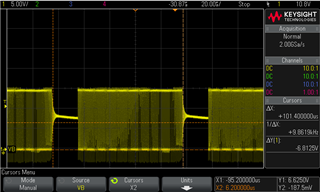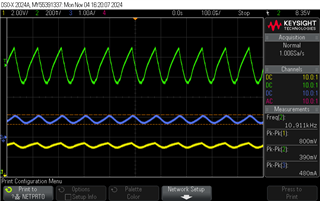Other Parts Discussed in Thread: BQ25798
Tool/software:
Hi
We've a custom design with a BQ25792 charging a 2S Li-ion pack.
The circuit generally works as expected, we can start and stop charging and vary charge current via I2C. Layout is appears pretty good and switching edges are clean with very minimal ringing. However, the design never seems to enter PFM mode at lighter (~500mA) charging current but instead goes straight to discontinuous mode, even before reducing the inductor on/off ratio significantly. This is despite never changing the default 'enabled' for PFM mode. We can read back "REG12_Charger_Control_3 Register" and confirm it's 0x00. Writing 0x10 to this to disable PFM makes no difference and neither does writing it back to 0x00.
Sometimes we get periods of bursts of DCM mode and then off, which can result in audible (and I'm told very unacceptable) high frequency tones.
We're (confirmed) switching at 1.5MHz with a 1uH inductor. Decoupling is pretty much as per the reference design, no ship FET or input muxing (power direct to VBUS and AC1/2), and thermistor disabled via REG18 TS_IGNORE bit.
We've tried a real battery packs and a battery emulator, with pack at 6V to 8.4V, and VIN of 11 - 15V.
We've confirmed another PCB behaves in the same way.
Is there anything else that can influence this switchover?
Part code is 0AANLZ8.



